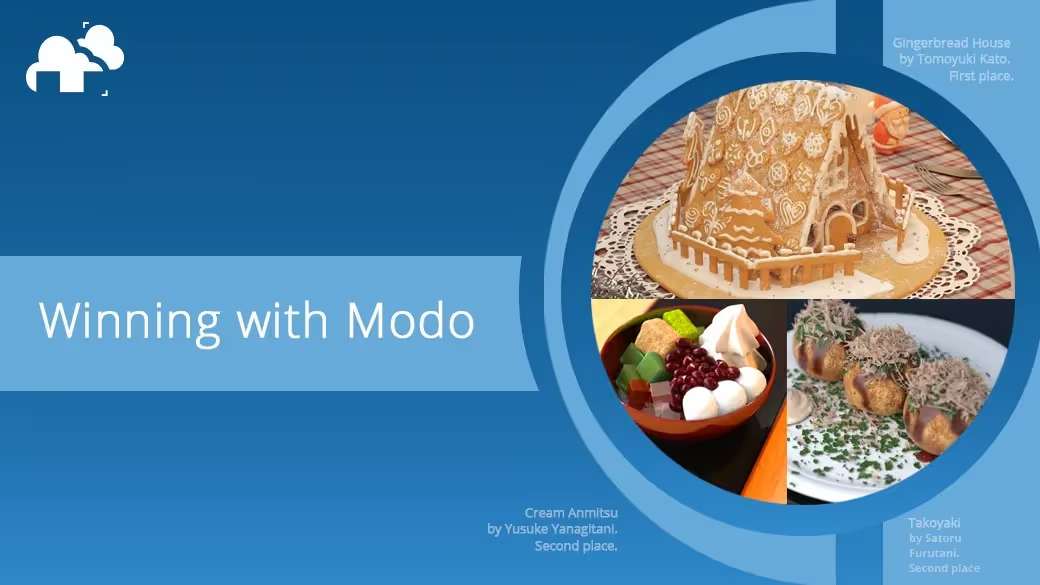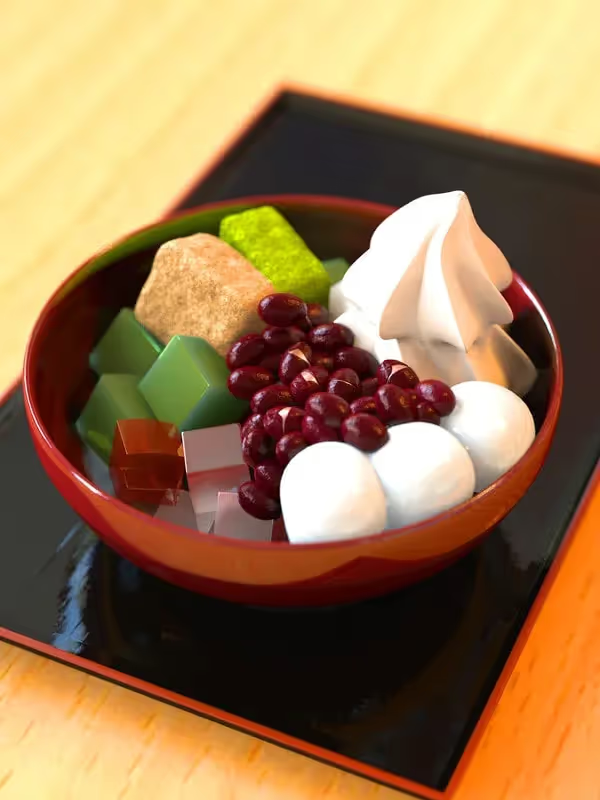
For its recently concluded 3D contest, Modo gave this prompt to 3D designers in Japan: use Modo to create a realistic render of food. Guess who won? An architectural visualizer took the top prize while a designer of pachinko machines took second and a modeler of backgrounds for games were the runners-up.
If you’re wondering how people who work with 3D models of mostly inorganic things for a living (office buildings, arcade machines, and gaming backdrops) can be so good at rendering something as organic as food, read on and learn about some of the lessons and realizations the winners took from the competition.
First place winner Tomoyuki Kato decided to make a gingerbread house because it was particularly close to his heart. “I decided to create a cookie house as a nod to my childhood memories,” said Tomoyuki.
As a result, his 3D render has an outstandingly unique atmosphere to it. Tomoyuki’s output has a vibe to it that can only be achieved by recalling fond memories that are deeply personal. Even without seeing any people in the image, you get this feeling that perhaps a big family is gathered, laughing, connecting, each one feeling at home with the others – exactly the effect Tomoyuki was after. “In order to make the design more appealing, I emphasized the importance of "storytelling," imagining that the house was handmade by a family,” he said.
As the kids like to say today, Tomoyuki’s Gingerbread House is a mood.

(Got a personal project you need to render? Check out our cost calculator.)
While the overall appeal of Tomoyuki’s image is definitely more than just the sum of its parts, the charm perhaps comes from the touches of intentional imperfections that the artist so skillfully employed. “I aimed for something with a hand-made feel. I was conscious of eliminating any unnatural straight lines, and I attempted to remove the CGI look by distorting the cookies, creating wrinkles on the tablecloth, and tilting and crushing the cups.” said Tomoyuki.
He was so intent on dispelling all CG-ness from his output that he ended up doing something so analog and so manual for something as digital as a 3D render. “For the cookies on the roof, I didn't use a replicator or anything like that, so I chose each one and placed them on the roof as if they were actually made,” said Tomoyuki. For a moment there Tomoyuki sounded more like an artisan baker, less like a 3D artist. “It was fun to feel like I was actually making a cookie house,” he added.
While sticking to what he knew and what was close to his heart worked well for the overall feel of the image, stepping out of his comfort zone helped Tomoyuki achieve the effect that he wanted for certain specific details. Powdered sugar, it turns out, was a particularly tricky material to get right in 3D. “The only difficulty I encountered this time was with the powdered sugar. It took a lot of time to figure out how to create it. I applied the method of procedural textures and used nearly 10 types of powdered sugar,” explained Tomoyuki.
The thing is, Tomoyuki isn’t overly familiar with Modo’s procedural textures. “I rarely use this technique. It took about five days to get the desired result,” said Tomoyuki. “And even after I decided to use procedural textures, the trial and error continued.” The effort was well worth it.
Runner-up Yusuke Yanagitani had a similar experience. For his entry, he designed a bowl of anmitsu.

Of all the ingredients in this sumptuous dessert, the kinako and matcha pieces proved to be a challenge to Yusuke. “I found that making texture changes to the kinako and matcha powder using normal methods didn't give the results I wanted, so I ended up using fur to create a more realistic look. However, I had forgotten how to use fur, so I studied it again by following a tutorial,” said Yusuke. Stepping out of one’s comfort zone proved to be the right move yet again.
But out of all the winners, the one who truly embodied not sticking to what you know was the other runner-up, Satoru Furutani. “This was my first time using Modo,” said Satoru Furutani. “Thanks to the user-friendly interface of the Modo software, I did not encounter any significant problems during the project. I was still able to create a project of a certain level of quality with just a few simple settings, without the need for extensive trial and error.”
Wow. Talk about being outside one’s comfort zone. Of course, this doesn’t mean that this is the first time Satoru tried 3D modeling. He is an experienced 3D artist but Modo wasn't the software he regularly used for work. Still, it was pretty gutsy to join a competition using the software you’re a novice at. You don’t exactly know where the controls are, you’re not sure which terms correspond to which parameters, and you’re unfamiliar with its menus. To finish as a runner-up winner in a contest after just a few days of tinkering with the software is spectacular and shows real skill and knowledge of the craft.

As if dealing with modeling software for the first time wasn’t difficult enough, this contest was also the first time that Satoru used a render farm for a project. “This was also my first time using a render farm, but I didn't have any trouble understanding how to use it. I found the process to be quite straightforward and easy to navigate,” said Satoru. Whether it’s luck or skill or both, things worked out well for him. Those takoyaki balls look delicious.
All three winners worked on their Modo contest entries on the side as a personal project. They all had day jobs that took most of their time and had to squeeze in a few hours here and there after work for the contest. As such, time was truly their enemy. All three felt the time crunch. And as amazing as their final output looked, all three felt that there was something that they could have improved on if they had more time, especially after they received feedback from the jury, other artists, and the public.
“I don't usually have the opportunity to receive feedback on my work, so I am grateful for any comments I receive,” said first place winner Tomoyuki. “When someone points out something I could improve, I regret not putting more effort into it.”
“Some feedback I received noted certain things that I wanted to do in my work but ultimately was unable to due to time or technical constraints,” said runner-up winner Yusuke. “Some feedback pointed out issues with the subsurface scattering settings, which made me realize that I needed to do some additional studying.”
“I didn't have much time for this project, so I decided to create a Takoyaki dish since it's one of my favorite foods and can be made quickly,” said runner-up winner and first time Modo user Satoru. “While I wasn't able to fully realize my original idea for this project, I believe that the result could have been even more interesting if I had been able to execute it as I had initially envisioned.”
This feeling of not being done, of wanting to push the work and do better, is also a feeling shared by all three winners after their experience with the Modo modeling contest. They won render farm credits and all three vowed to use them at some point in the future to pursue new personal projects.
For Tomoyuki Kato, it’s all about expanding his skills. “I haven't had many opportunities to do personal creative work,” said Tomoyuki. “However, I've decided to continue this year and explore not only still images but also video production.”
For Yusuke Yanagitani, he sees the render farm credits more as an ace up his sleeve. “While I don't have any specific projects in mind at the moment, I would like to keep the credits as a ‘last resort’ option for when I'm facing a tight deadline,” said Yusuke.
For Satoru Furutani, the cloud rendering credits could be used to further his exploits in self-expression. “Up until now, I haven't had much opportunity to engage in personal creative projects,” said Satoru. “Since I received the credits this time, I am considering some ideas. I would like to create unique works that can be understood at a glance.”
Judging from the glance that their contest entries provided into their level of skill and depth of artistry, these 3D artists are far from done.
If you’re interested in seeing more work from these 3D artists, you can check out find more Tomoyuki's website, Yusuke's Twitter, and YouTube channel.